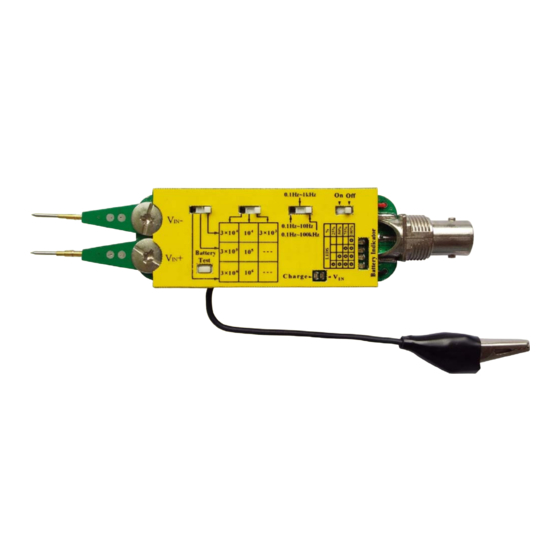
Table of Contents
Advertisement
Quick Links
Analog Technologies
MAIN FEATURES
Built-in rechargeable battery
Magnifications: 3,000×, 10,000×, 30,000×, 100,000×,
300,000×, 1,000,000×, 3,000,000×
Three filter bandwidths: 0.1Hz ~ 10Hz, 0.1Hz ~ 1kHz,
0.1Hz ~ 100kHz
LED low battery indicator function
BNC output terminal
Input probes with adjustable span
100 % Lead (Pb)-free and RoHS Compliant
INTORDUCTION
This noise measurement amplifier, ATNMA1.0, is
designed to test ultra low noises which cannot be
measured by oscilloscope, such as nV and µV level noises,
for electronic modules. This amplifier measures the noise
signals through touching the point that needs testing, then
amplifies the detected noise signals, and select the
measuring range of frequencies. The rechargeable battery
energy is 500mAH, can be used more than 20 hours. The
rechargeable battery full voltage is 4.2V. The low noise
amplifier includes one rechargeable battery, one coaxial
cable, some probes.
This noise measurement amplifier assembly has 5
portions:
1. Amplify Magnifications
For example:
3000×:
2352 Walsh Ave. Santa Clara, CA 95051. U. S. A. Tel.: (408) 748-9100, Fax: (408) 748-9111
©Copyrights 2000-2015, Analog Technologies, Inc. All Rights Reserved. Updated on 8/28/2015
Noise Measurement Amplifier
Figure 1. Physical Photos of ATNMA1.0
Measure the noises between 1µV to 100µV. Toggle
magnification switch S2 to S2-1 and S5 to S5-1.
10,000×:
Measure the noises between 0.1µV to 1µV. Toggle
magnification switch S2 to S2-2 and S5 to S5-2.
300,000×:
Measure the noises less than 0.1µV. Toggle magnification
switch S2 to S2-3 and S5 to S5-3.
10,000,000×:
Measure the noises less than 1nV. Toggle magnification
switch S2 to S2-3 and S5 to S5-3.
Please see the switches location in figure 2 and figure 3.
2. Noise Frequency Range
0.1Hz ~ 10Hz: toggle S2 to S2-1
0.1Hz ~ 100 kHz: toggle S2 to S2-2
0.1Hz ~ 1 kHz: toggle S2 to S2-3
Please see the switches location in figure3
Noise Measurement Amplifier
Figure 2. Physical Label of ATNMA1.0
www.analogtechnologies.com
www.analogti.com
ATNMA1.0
1
Advertisement
Table of Contents

Summary of Contents for Analog Technologies ATNMA1.0
- Page 1 0.1Hz ~ 1 kHz: toggle S2 to S2-3 Please see the switches location in figure3 For example: 3000×: 2352 Walsh Ave. Santa Clara, CA 95051. U. S. A. Tel.: (408) 748-9100, Fax: (408) 748-9111 www.analogtechnologies.com ©Copyrights 2000-2015, Analog Technologies, Inc. All Rights Reserved. Updated on 8/28/2015 www.analogti.com...
- Page 2 At this time press the 2352 Walsh Ave. Santa Clara, CA 95051. U. S. A. Tel.: (408) 748-9100, Fax: (408) 748-9111 www.analogtechnologies.com ©Copyrights 2000-2015, Analog Technologies, Inc. All Rights Reserved. Updated on 8/28/2015 www.analogti.com...
- Page 3 Figure 9. Calculation formula Diagram of ATNMA1.0 2352 Walsh Ave. Santa Clara, CA 95051. U. S. A. Tel.: (408) 748-9100, Fax: (408) 748-9111 www.analogtechnologies.com ©Copyrights 2000-2015, Analog Technologies, Inc. All Rights Reserved. Updated on 8/28/2015 www.analogti.com...
- Page 4 AMPLIFIER ITSELF NOISE Table 1 show the amplifier itself noise at different frequency. 2352 Walsh Ave. Santa Clara, CA 95051. U. S. A. Tel.: (408) 748-9100, Fax: (408) 748-9111 www.analogtechnologies.com ©Copyrights 2000-2015, Analog Technologies, Inc. All Rights Reserved. Updated on 8/28/2015 www.analogti.com...
- Page 5 Figure 13. BNC-BNC Connector 1.5m Coaxial Cable Figure 14. Charger and USB cable of ATNMA1.0 2352 Walsh Ave. Santa Clara, CA 95051. U. S. A. Tel.: (408) 748-9100, Fax: (408) 748-9111 www.analogtechnologies.com ©Copyrights 2000-2015, Analog Technologies, Inc. All Rights Reserved. Updated on 8/28/2015 www.analogti.com...
- Page 6 ATI for its products and/or projects. 2352 Walsh Ave. Santa Clara, CA 95051. U. S. A. Tel.: (408) 748-9100, Fax: (408) 748-9111 www.analogtechnologies.com ©Copyrights 2000-2015, Analog Technologies, Inc. All Rights Reserved. Updated on 8/28/2015 www.analogti.com...











Need help?
Do you have a question about the ATNMA1.0 and is the answer not in the manual?
Questions and answers